Top 5 Laptop Portable Power Banks in 2025: Buyer’s Guide
You move fast—between café meetings, red‑eye flights, and weekend trips up the coast—so your gear has to keep up. A reliable laptop portable power bank gives you the freedom to finish that deck, stream the match, or smash out a uni assignment long after the seat‑back outlets or spare wall sockets disappear.
In this guide, you’ll find the 5 best options for 2025, hand‑picked for Aussies like you who need serious wattage, airline‑safe batteries, and bags‑on‑backs portability. We’ll also break down the key specs that actually matter—capacity, USB‑C PD output, recharge time, and more—so you can choose with confidence.
5 Best Laptop Portable Power Banks in 2025
Need a safety net when the café socket is already claimed or camping off-grid? The five picks below cover different capacities, ports, and speeds so you can match a portable laptop charger power bank to the way you actually work and travel.
1. EcoFlow RAPID Magnetic Power Bank 10,000mAh
A quick morning charge in your flat isn’t always enough—especially if you’re bouncing between lectures, a client pitch, and the late-arvo train home. That’s where the EcoFlow RAPID Magnetic Power Bank steps up.
At just 258g and no larger than a deck of cards, it snaps magnetically to your MagSafe-enabled iPhone for cable-free 15W top-ups, yet still pushes 65 W through its built-in USB-C cable when your 13-inch MacBook Air starts blinking red.
The digital read-out tells you exactly how much juice is left (no vague LED bars), and a kick-stand props your phone for video calls while it charges. Plug it back in while you grab a coffee and the RAPID refuels up to 70 % in roughly half an hour—fast enough to keep pace with a hectic schedule.
It even lets you tag the digital screen with your name or a fun emoji in the EcoFlow app — a nice little touch that helps your portable charger stand out in a sea of identical matte black bricks at the co-working space.
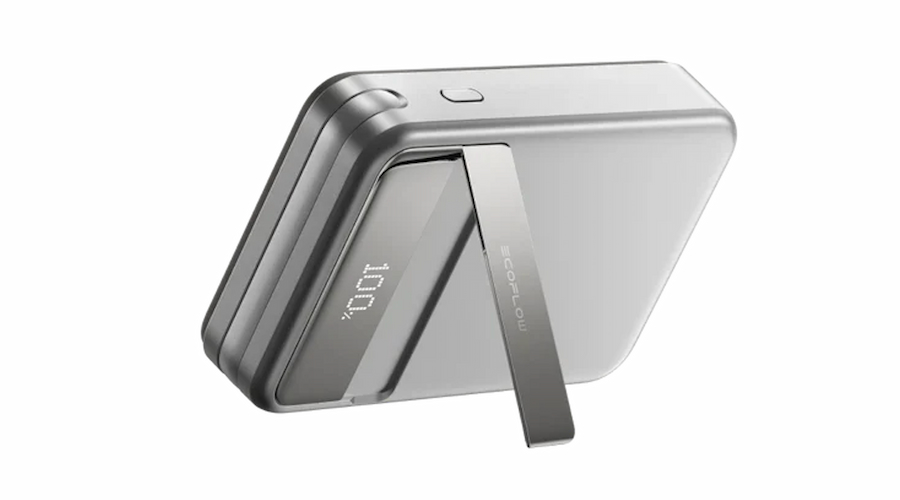

Key features:
65W built-in USB-C cable plus a second USB-C port (both input/output) for laptop charging without extra leads
Qi2-certified 15W magnetic pad; boosts an iPhone 15 Pro to 50 % in ~40 min
Flash recharging: 65W input charges power bank from 0 – 70 % in under 33 min
Smart digital display shows remaining capacity, current output, and time to full
EcoFlow app control lets you personalise boot screen, locate the bank with a buzzer, or enable Healthy Charging Mode to slow battery wear
Kick-stand supports portrait or landscape viewing while charging
Car-grade low-resistance cells with real-time temperature monitoring (50 checks / sec) to keep things cool and extend lifespan
108 × 70 × 22.9 mm, 258g—fits easily into a hoodie pocket or seat-back pouch
2. INIU B63 Power Bank 25,000mAh
When your 16-inch workstation drains its cells halfway through editing drone footage, you need more than a pocket charger. The INIU B63 carries airline-safe 25,000mAh cells and pushes 100W over USB-C, so you can revive power-hungry laptops at full speed without hunting for the last wall socket in the terminal.
Dual USB-C outputs let you split wattage between devices; run the laptop on 65W while a phone grabs the remaining 35W, all tracked on a crisp battery read-out. The same port gulps 65W on refill, topping the bank in roughly two hours—fast enough to reset during a layover.
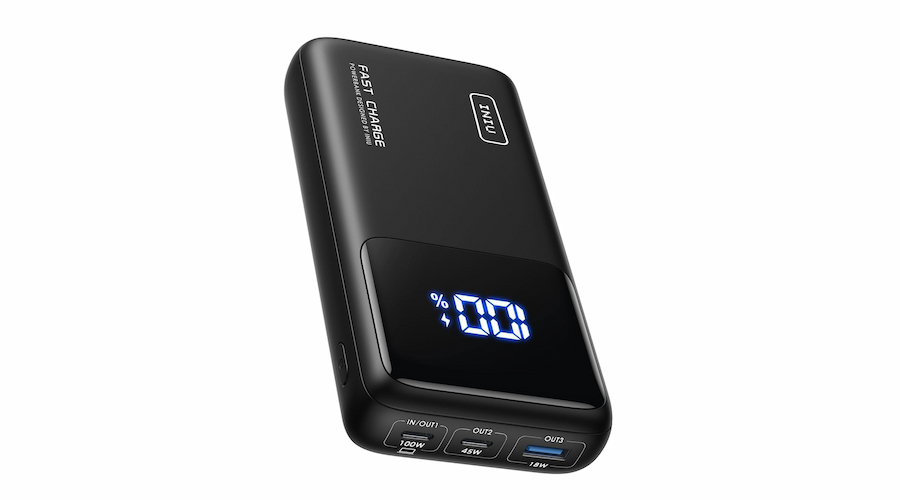

Key features
100W USB-C output for flagship laptops and Steam Deck full-speed charging
25,000mAh, flight-compliant capacity (~1.5 charges for a 13-inch MacBook Pro)
Dual USB-C plus USB-A for three-device charging; 65W in/100W out on main port
65W self-recharge in about 2h
Clear percentage display and battery-health safeguards
3. Anker 737 Power Bank 24,000mAh
The Anker 737 portable laptop power bank turns your wait at the train station into a useful time. Thanks to Power Delivery 3.1 and bi-directional silicon, it can pour 140W into a MacBook Pro 16”—or swallow the same energy back in for a rapid self-top-up.
Three ports (2× USB-C, 1× USB-A) cover headphones to tablets, while the high-contrast screen spells out real-time input, output, and minutes to empty, so you’re never guessing how many stops are left.
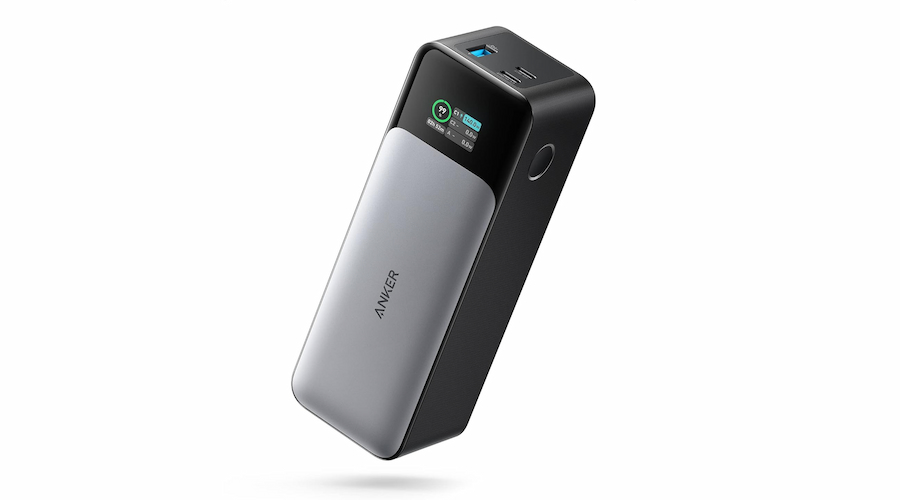

Key features
140W single-port USB-C output; charges MacBook Pro 16” to 50 % in ~40 min
PD 3.1 two-way: same port fast-charges the bank itself
24,000mAh capacity; roughly five iPhone 15 recharges or one full MacBook Air cycle
Smart digital display with power flow and time-to-full indicators
4. UGREEN 25188 Power Bank 20,000mAh
If you shuttle between lecture halls or job sites and like to travel light, UGREEN’s 20,000mAh trims grams without trimming speed. It weighs about 20 % less than similar 20K packs yet still fires 100W through its primary USB-C, enough to lift a 15-inch MacBook Air from flat to 42 % in half an hour.
Two extra outputs—30W USB-C2 and 22.5W USB-A—let you juice a phone and camera at the same time. Plug the bank into a 65W wall brick and it refills from empty in around 1.6 hours, so an overnight lapse or mid-day café stop has you covered.
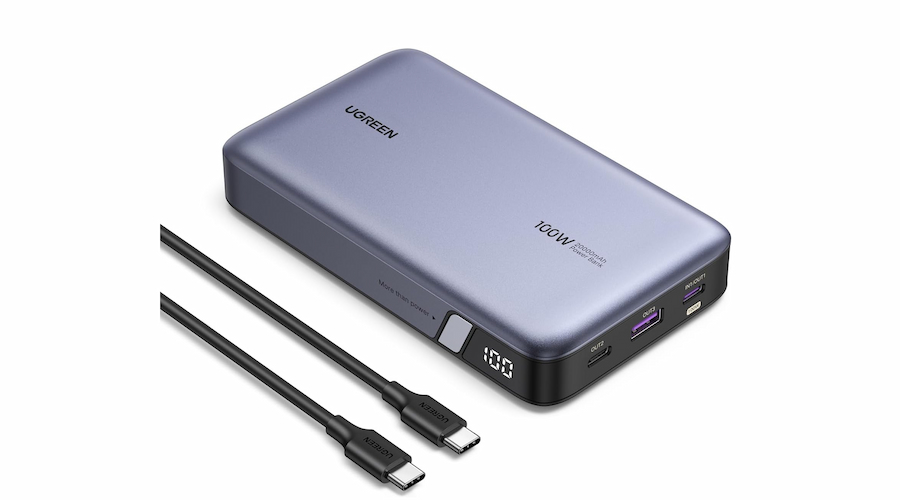

Key features
100W USB-C1 output plus 30W USB-C2 and 22.5W USB-A for three-device “flash charge”
20,000mAh capacity: 4.5 iPhone 15 Pro charges or 1.1 MacBook Air 15” cycles
65W self-recharge in ~1.6 h via USB-C1
LED screen shows exact remaining percentage; includes 240W USB-C-to-C cable
5. Cygnett 148W Laptop Power Bank 27,000mAh
Long-haul flyers and multi-device road warriors will appreciate Cygnett’s heavyweight. With 27,000mAh on tap—just under the cabin limit—it can push a class-leading 140W through either USB-C or feeding your laptop, phone, and earbuds simultaneously for a combined 148 W.
Pass-through support keeps everything alive when you finally find a socket, and the included zip case stops cables tangling in your backpack. Expect up to 1.5 cycles on a 16-inch workstation or five full iPhone 16 charges before you need to hunt mains again.
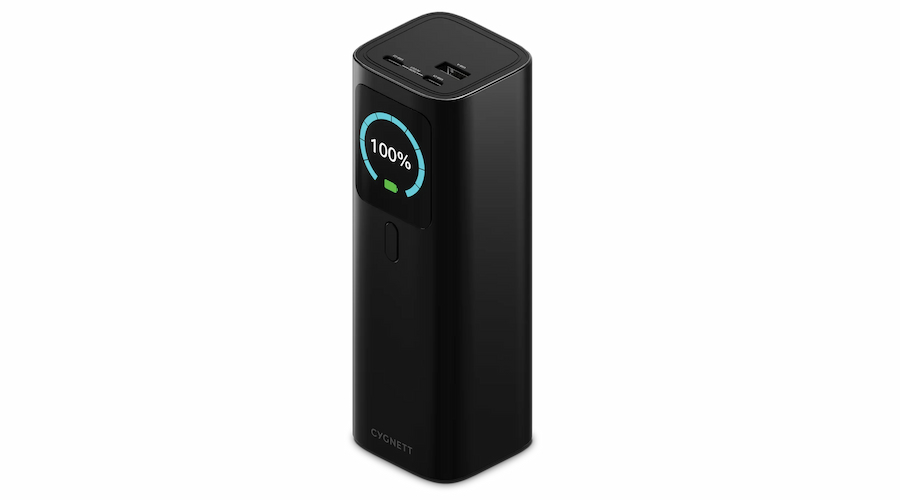

Key features
140W single-port USB-C PD 3.1 output; total 148W shared across 2× USB-C + 1× USB-A
27,000mAh capacity at the legal flight limit; 4–5 phone charges or 1.5 laptop cycles
Pass-through charging for laptop + bank from one wall adapter
Travel kit: compact EVA case and short cables to stay organised
Key Features to Look for When Choosing the Best Laptop Portable Power Bank
Before you tap “Add to Cart,” line up your shortlist against the criteria below. A little homework now saves frustration when you’re relying on the power bank the most.
Power Output (Wattage)
Your laptop’s charger rating tells you how many watts it needs. A modern ultrabook sips 45–65W; a 16-inch workstation may demand up to 140W. Choose a laptop portable power bank whose single-port USB-C output meets—or safely exceeds—that figure.
Anything less and your machine will crawl or even discharge while “charging.” Look for Power Delivery (PD) 3.0 or the newer PD 3.1 spec if you own a high-end MacBook Pro, Surface, or gaming handheld.
Battery Capacity (mAh / Wh)
Capacity dictates how many extra hours you’ll gain. Convert milliamp-hours to watt-hours (mAh ÷ 1000 × voltage) to compare apples to apples. Australian and international airlines cap carry-on batteries at 100Wh (≈ 27,027mAh at 3.7V), so anything around 20 – 27K mAh is the sweet spot for travel. Smaller packs (10 – 15K) weigh less and still finish a meeting.
Input Speed (Self-Recharge)
A beast that takes eight hours to refill isn’t much use between meetings. Check the “input” rating: 60 – 65W means the bank itself can recharge from empty during a lunch break. Some newer units accept 100W in, slashing downtime to about an hour with a suitable wall brick.
Port Configuration
Single high-watt USB-C: best if you only care about your laptop.
Dual USB-C + USB-A: lets you top up a phone or tablet while the laptop drinks most of the juice.
Built-in cable or MagSafe/Qi2 pad: handy when you forget leads, but make sure the wattage still matches your needs.
Size, Weight, and Ergonomics
All-day capacity adds grams. The trade-off: a 20K pack usually sits around 450g, while a 10K model can hide in a hoodie pocket at ~260g. Consider your daily carry—messenger bag, backpack, or coat pocket—and pick the largest battery you’ll actually bring along.
Display and App Extras
A numeric read-out (or companion app) is far more useful than four vague LEDs. Look for banks that show percentage remaining, live output wattage, and time-to-empty; you’ll know exactly when to plug back in. Some apps also enable “battery-health” modes that slow charging overnight to prolong cell life.
Safety and Thermal Management
High currents generate heat, especially in summer. Quality power banks use temperature sensors, auto-cut-off circuitry, and low-resistance cells to stay within safe limits. Certifications such as CE, RCM (for Australia), and Qi2 for wireless pads add peace of mind.
Bonus Conveniences
Pass-through charging lets you power the laptop and refill the bank from a single wall socket.
Kick-stands prop your phone for calls or Netflix while charging.
Included 100 W+ cable means one less accessory to buy.
Conclusion
Choosing the right laptop portable power bank isn’t about ticking boxes; it’s about matching your real‑world routine. Whether you camp off‑grid, code on the train, or hop between client sites, the models we’ve highlighted cover every use‑case and budget. Keep the feature checklist close, weigh up capacity versus weight, and you’ll land on the charger that keeps your laptop—and your plans—running without interruption.
FAQs
Can you charge a laptop with a portable power bank?
Yes. As long as the bank’s USB‑C (or DC) output meets your laptop’s wattage requirement—say 45 W for an ultrabook or up to 140W for a 16‑inch MacBook—you can plug straight in and recharge just like from a wall brick. Look for Power Delivery (PD) support and the same voltage profile your laptop charger uses.
Is there a power bank that can charge a laptop?
Yes, there’s a wide range of laptop‑grade power banks today. For instance, the EcoFlow RAPID Magnetic Power Bank 10,000mAh supplies up to 65W over USB‑C Power Delivery, enough to fast recharge a 13‑inch MacBook Air or similar ultraportable. As long as a power bank’s single‑port output meets your laptop’s wattage requirement and supports PD, it will top up your computer just like a wall charger.
Is it good to use a power bank for a laptop?
It’s perfectly safe if you use a reputable, PD‑certified power bank. You gain extra runtime on flights, in class, or outdoors, and modern battery packs include over‑current, over‑voltage, and thermal protection. Just pair the right wattage (often 65W+) and capacity (10K+) to your workflow so you’re not carrying excess weight.
Do power banks exist for laptops?
Yes, power banks aren’t just for phones anymore. Laptop‑grade banks offer larger batteries (15,000–27,000mAh) and higher outputs (60 – 140W) through USB‑C or DC ports. They’re widely available online and in electronics stores under “laptop power bank” or “PD power bank” categories.